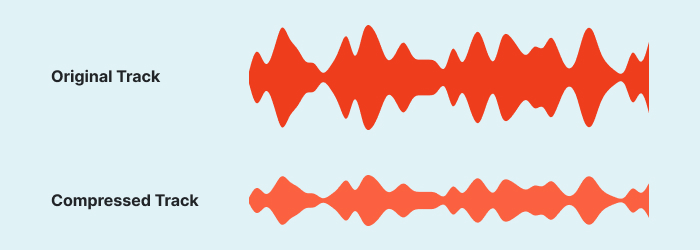When you learn more about mixing you will come across many new useful mixing concepts and tricks. One of the most useful concepts is parallel compression.
With this tool in your arsenal, you can create better-sounding and more advanced mixes in a very short amount of time.
But first, you need to understand how it works. Then you should know when to use it. And finally, with lots of practice, you will master it.
In this post, I will explain what parallel compression is, how it works, and what instruments work great with it.
How Parallel Compression Works
Parallel compression is a mixing concept when you duplicate a track and use hard compression on a copied track. Then you blend the compressed track with the original, uncompressed track.
This way you have an original track without a compressor on it. But you have a copy of the same track with very hard compression. This track has no dynamics.
The compressor settings might be different from track to track but the goal is to use hard compression. You need a high ratio, a very fast attack, and a slow release. You need to make copied track very undynamic.

The reason why you might do it is that you retain the original sound source with all transients. And after blending two sounds you get the more powerful sound that cuts in the mix.
Traditional use of compression is when you compress the original track. But you lose control of your compression and the sound. With parallel compression, you have more freedom and flexibility.
Some mixing engineers use both methods, traditional and parallel together. They use very mild compression settings on the original track but also implement parallel compression.
There is no right or wrong way to use it. You just need to try a different approach and use what you like.
When To Use Parallel Compression
A question you might ask is when to use parallel compression and what instruments work well with it. That’s a logical question and I’m here to answer it.
In general, parallel compression can be used on every track but it works better with specific instruments.
I like to use it on drums, vocals, and bass but you can use it on acoustic or clean electric guitars too.
Parallel Compression On Drums
I love using parallel compression on drums. It becomes more powerful, and prominent, and cuts in the mix very well.
You can use it on every drum track separately but I like using it on the whole drum. I think it works better and I get better sound and this is how I do it.
First, I mix drums separately in the traditional way. Then I create a main drum bus track. Sometimes I use very little EQ and compression on it.

So I have one drum track which is my main source for drums. This is the sound I want to hear in my mix. But to make it better and more powerful I implement parallel compression.
I create a copy of that track and apply a compressor plugin. You can use your favorite compressor plugin. It doesn’t matter but I will show you my favorite ones.
The compressor settings I use may vary from song to song but I like to use very hard compression. The ratio is 10:1 or more, fastest attack and slower release.
And finally, I blend two tracks – the volume of the main drum bus track is already set up and the compressed track is at zero.
Then I slowly start leveling up the volume fader of the compressed track and listening to how it affects the drum sound.
I don’t want the compressed track to be prominent. I just want to blend it so the drum sound becomes more powerful, and even, and cuts in the mix. I do it until I’m satisfied with the results.
Parallel Compression On Vocals
The approach for vocals is the same. You have a main vocal track and compress the copied track but the settings might be different.
I don’t like to use as hard compression when mixing vocals as I use on drums. It might have a bad impact on the overall vocal sound.

So, I start a normal amount of compression something like 6:1 or 8:1, and do tweaks accordingly. The goal is to listen to the sound carefully and make wise decisions.
Different vocal performance requires a different approach. Is it a rock or pop song? Is the singer female or male? How powerful voice does the singer have?
All these nuances are very important when using parallel compression on vocals.
Parallel Compression On Bass
The bass guitar is a little different. There are different ways to mix bass guitars and the compression approach depends on it.
There are times when I don’t use parallel compression on a bass guitar track. But sometimes it’s required.
If you want to have a simple bass sound then this method is not required. But when you want to have more control of the bass sound, then you should implement the parallel compression method.

For example, I love using parallel compression on clean bass tones. But I rarely use it on overdriven or high-gain bass tones.
In this case, I prefer using a compressor on the original bass track. But your approach might be different.
Everything comes down to what we like. If a particular method works for us and we like the sound, then it’s the best method.
There is no right or wrong way to do parallel compression or mixing in general.
Best Parallel Compression Plugins
As I said, you can use any compressor plugin you want but I have my favorite ones. I think they do the perfect job when it comes to parallel compression.
1. Kush Audio UBK-1
I love the UBK-1 compressor for its features and ease of use. When you do parallel compressing you don’t need a complicated interface or options. And it’s awesome for that purpose.
Also, UBK-1 by Kush Audio has a built-in saturation module which makes it perfect. You can add a little distortion to your compressed track and it will help your track to cut in the mix.
2. EL8 Distressor
EL8 Distressor is a popular plugin among mixing engineers. It’s also a great mastering compressor. But I like to use it for parallel compressing. It works great for that. And it’s very simple to use.
It has an attack, release, input, and output knob. And a very diverse ratio section. You can use it as a limiter too. In my opinion, it works perfectly with drums.
3. DBX 160
And my third favorite plugin for parallel compression is DBX 160. Perhaps the simplest one. And that’s not the only reason why I like it. The other reason is that it sounds awesome.
Just set the threshold and amount of compression to your liking and that’s it. You don’t need more. Also, it works as a limiter too. I like using it on drums and vocals.
Conclusion
Parallel compression is a very useful mixing trick to have in your arsenal. It makes mixing much easier and fun. You get more control and flexibility than you have with the traditional compression method. It works with any style of music and for every instrument. But you get the most out of it with drums, vocals, and bass guitar.
Try to implement it with your mixing workflow and see its power. I recommend starting practice with vocals because it’s the easiest. Then you can try it on drums or other instruments.
